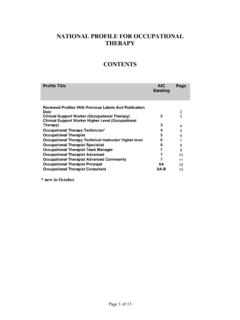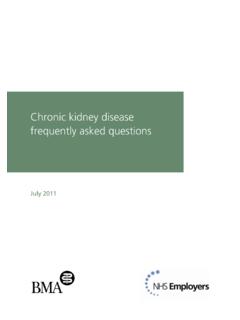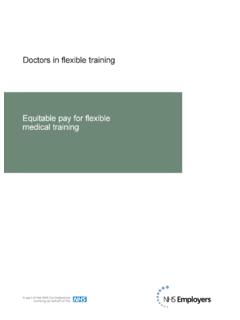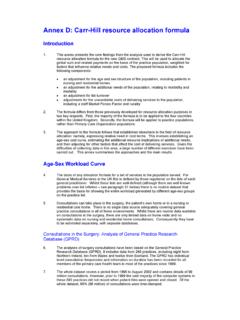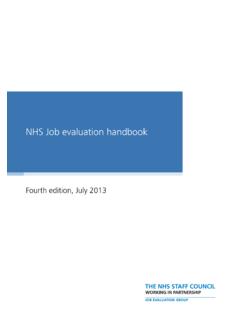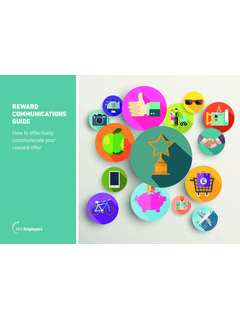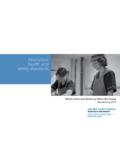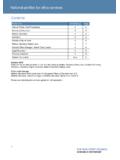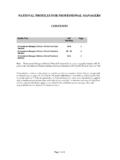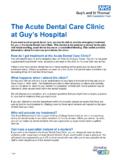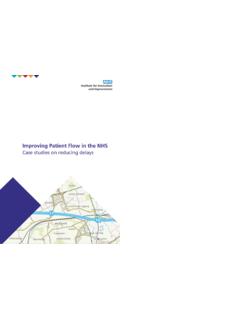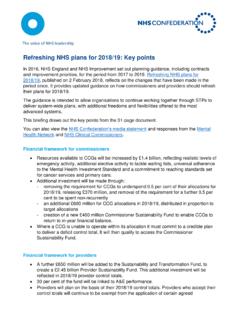Transcription of AVOIDING UNPLANNED ADMISSIONS ENHANCED …
1 1 AVOIDING UNPLANNED ADMISSIONS ENHANCED service Guidance and audit requirements April 2014 AVOIDING UNPLANNED ADMISSIONS ENHANCED SERVICE: proactive CASE FINDING AND CARE REVIEW FOR VULNERABLE PEOPLE GUIDANCE AND AUDIT REQUIREMENTS A programme of action for general practice and clinical commissioning groups NHS England Gateway reference: 01520 2 AVOIDING UNPLANNED ADMISSIONS ENHANCED service Guidance and audit requirements CONTENTS SECTION 1 BACKGROUND AND PURPOSE 3 SECTION 2 REQUIREMENTS 5 Practice availability 5 proactive case management and personalised care planning 6 Reviewing and improving the hospital discharge process 10 SECTION 3 Internal practice review DATA 10 SECTION 4 MONITORING SECTION 5 PAYMENT AND VALIDATION SECTION 6 OTHER PROVISIONS RELATING TO THIS ENHANCED SERVICE 19 ANNEX A TEMPLATE LETTER TO INFORM PATIENTS OF ENROLMENT INTO ENHANCED SERVICE 20 ANNEX B PRINCIPLES OF PERSONALISED CARE PLANNING 30 ANNEX C 31 ANNEX D 34 SECTION 7 42 3 AVOIDING UNPLANNED ADMISSIONS ENHANCED service Guidance and audit requirements SECTION 1.
2 BACKGROUND AND PURPOSE UNPLANNED ADMISSIONS to hospital are distressing and disruptive for patients, carers and families. Many UNPLANNED ADMISSIONS are for patients who are elderly, infirm or have complex physical or mental health and care needs which put them at high risk of UNPLANNED admission or re- admission to hospital. This ENHANCED service (ES) is designed to help reduce avoidable UNPLANNED ADMISSIONS by improving services for vulnerable patients and those with complex physical or mental health needs, who are at high risk of hospital admission or re- admission . The ES should be complemented by whole system commissioning approaches to enable outcomes of reducing avoidable UNPLANNED ADMISSIONS . The ES will commence on 1 April 2014 for one year, subject to review. The funding to support this service has been taken from the retirement of the quality and productivity (QP) domain of the Quality and Outcomes Framework (QOF) and the 2013/14 Risk Profiling and Care Management ES which ceased on 31 March 2014.
3 In addition to these changes, wider amendments to the GMS contract in 2014/15 have also been made to further enable practice staff time to be focused on holistically improving the health and wellbeing of their patients, particularly those who are the most vulnerable or have long term conditions. The ES requires practices to identify patients who are at high risk of UNPLANNED admission and manage them appropriately with the aid of risk stratification tools, a case management register, personalised care plans and improved same day telephone access. In addition, the practice will also be required to provide timely telephone access to relevant providers to support decisions relating to hospital transfers or ADMISSIONS in order to reduce avoidable hospital ADMISSIONS or accident and emergency (A&E) attendances. The risk stratification element of the ES will apply to a minimum of two per cent of adult patients (aged 18 and over) of the practice's registered list.
4 In addition to this, any children with complex health and care needs requiring proactive case management and personalised care plans should also be considered for inclusion on the register. Patients identified as being at high risk of UNPLANNED admission and on the case 4 AVOIDING UNPLANNED ADMISSIONS ENHANCED service Guidance and audit requirements management register will be assigned a named accountable GP (and where relevant a care coordinator). This person will have overall responsibility for coordinating the patients care and sharing information with them, their carer (if applicable) and, if the patient consents, other professionals and organisations involved in their care. These patients will have a personalised care plan which will have been developed collaboratively between the patient, their carer (if applicable) and the named accountable GP and/or care coordinator, detailing how their ongoing health and care needs will be addressed to reduce their risk of avoidable admission to hospital.
5 Patient care will also be reviewed at an interval agreed with the patient and if plan. Practices should also be aware of the needs of carers. Participating practices will review emergency ADMISSIONS and A&E attendances of patients on the case management register ( to understand why these ADMISSIONS or attendances occurred and whether they could have been avoided). They will also review patients newly identified as at risk and other vulnerable patients (such as those living in care or nursing homes) to identify factors which could have avoided the admission or A&E attendance, with a view to taking appropriate action to prevent future episodes. These factors include both changes that the practice can make to their management of these patients, other community support services that need to be put in place for these patients and also changes to admission and discharge processes that will be fed back by the practice to commissioners. This guidance should be read in conjunction with the 2014/15 NHS England ES 1 5 AVOIDING UNPLANNED ADMISSIONS ENHANCED service Guidance and audit requirements SECTION 2.
6 REQUIREMENTS The requirements for taking part in the ES are as follows: i. Practice availability i. The practice will provide timely telephone access via an ex-directory or bypass number to ambulance staff and A&E clinicians to support decisions about hospital transfers and ADMISSIONS relating to any patient on their registered list2. This could, for example, be done by providing different extension options to callers to the practice, as long as this gets the caller straight through to the practice as a priority call. Where an ambulance staff member or A&E clinician specifically ask to speak to a clinician in the practice, then they should be enabled to do so whenever practically possible. Access should be within a suitable timeframe recognising that the query being raised relates to whether or not to transfer or admit a patient to hospital it may be prompt, within an hour or same day. The area team will be required to compile a list of all the by-pass or ex-directory telephone numbers for practices participating in the ES and share it with relevant ambulance staff and A&E clinicians.
7 Ii. The practice will provide timely telephone access via an ex-directory or bypass number to care and nursing homes, encouraging them to contact the patient's GP practice to discuss options before calling an ambulance (where appropriate for example, this is not applicable if the patient is at high risk of severe harm or death, if treatment is delayed). This could, for example, be done by providing different extension options to callers to the practice, as long as this gets the caller straight through to the practice as a priority call. Where care or nursing home staff specifically ask to speak to a clinician in the practice, then they should be enabled to do so whenever practically possible. Access should be within a suitable timeframe recognising that the query being raised relates to whether or not to call an ambulance it may be immediate or within a couple of hours. The area team will be required to compile a list of all the by-pass or ex-directory telephone numbers for practices participating in the ES and share it with relevant care and nursing homes.
8 Iii. The practice will provide timely telephone access to other care providers ( mental health and social care teams) who have any of the practice's registered patients in crisis and who are at risk of admission . Where a specific request is made by one these individuals to speak to a clinician in the practice, then they 2 This number is only to be used when ambulance staff and A&E clinicians require support from a ns about transferring or admitting patients. 6 AVOIDING UNPLANNED ADMISSIONS ENHANCED service Guidance and audit requirements should be enabled to do so whenever practically possible. Access should be within a suitable timeframe recognising that the query being raised relates to a patient in crisis it may be immediate, within an hour or same day. iv. The practice will provide patients identified on the case management register, who have urgent clinical enquiries, with a same day telephone consultation and where required follow-up arrangements ( home visit, face-to-face consultation, visit by community team etc.)
9 This same day telephone consultation will be with the most appropriate healthcare professional in the practice. ii. proactive case management and personalised care planning i. The practice will use an appropriate risk stratification tool or alternative method, if a tool is not available, to identify vulnerable older people, high risk patients and patients needing end-of-life care who are at risk of UNPLANNED admission to hospital. If a risk profiling tool is used, clinical commissioning groups (CCGs) should ensure that a suitable tool has been procured for practice use. ii. The risk stratification tool or other alternative method used should give equal consideration to both physical and mental health conditions. iii. The practice will establish a case management register of patients identified as being at risk of an UNPLANNED hospital admission without proactive case management. This register will be a minimum of two per cent of the practice's registered3 adult patients (aged 18 and over).
10 The minimum number of patients to be on the register each quarter, will be set on the first day of the respective quarter starting from quarter two ( 1 July 2014 for quarter two, 1 October 2014 for quarter three and 1 January 2015 for quarter four). The minimum register size will be calculated as two per cent of the practice list size (patients aged 18 and over) from Exeter on each of these days. In addition to this two per cent, any children (aged 17 and under) with complex physical or mental health and care needs, who require proactive case management, should also be considered for the iv. In each quarter a tolerance of will be allowed to account for situations which temporarily lead to a dip in the number of patients on the register at the end of that quarter. However, practices will need to ensure that over the last three quarters of the year the register covers at least an average of two per cent of the practice's registered adult patients.
